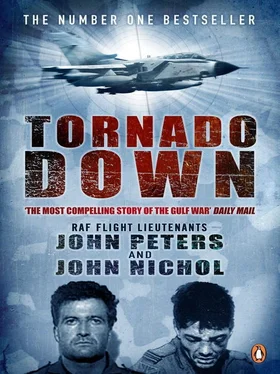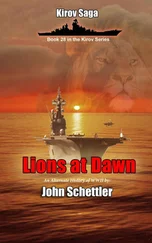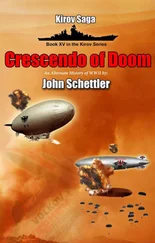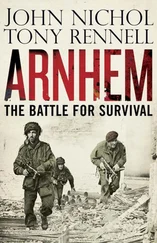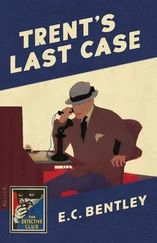To carry out practice attacks on the Navy, the Tornados split into pairs. Their instructions were very simple: to sink, ‘for exercise’, the ship in question. One Tornado acts as the sea-skimming missile, with another acting as the launch aircraft. The ‘missile’ Tornado tucks itself right up close to the other, until it is sitting just underneath the launch aircraft’s wing. Both of us would fly very low, and very close together, as low and as close as we dared…
The Combat Air Patrol (CAP) covering the ships ought to nail us first, 100 miles out. It does not. We come on. Fifty miles, forty miles. Onboard the target vessel, deep in the belly of the ship, in the hushed darkness of the Operations Room, the radar operators are watching, watching the rotating radar sweep. Suddenly a blip appears at thirty miles – us.
We are ‘popping’ to illuminate our target. John switches his radar on. Four sweeps are enough. The ship’s electronic listening gear ‘hears’ our radar and confirms the worst fears of the Anti-Air Warfare Officer. ‘Red nine-zero, hostile, closing. Missile attack!’
The nerve centre alerts the ship’s defences, the missile launchers swing expectantly in our direction. Suddenly, the uppermost Tornado of the attacking pair pulls up sharply, turning hard away from the ship. Missile away. The ‘missile’ aircraft engages combat power, glues itself right down onto the surface of the sea, hugging the wavetops, arrowing in even faster and lower at the ship, really low now, bouncing on the pressure wave between the Tornado and the sea. The ship’s Ops Room is buzzing like a hornet’s nest. Incoming! In combat, anti-missile missiles had not had spectacular results in dealing with sea-skimmers. Their best hope is the ship’s Phalanx rotary cannon, its six barrels spitting out 3,000 rounds per minute. But they don’t get a minute to shoot the missile down – more like four seconds. The command on board has very little time to make the right decisions, to protect the ship from the sea-skimmer rocketing in. What is fascinating is the way these massive warships can turn virtually on a sixpence, skidding themselves round in the sea until they are nose-to-nose with attacking aircraft like our own.
They fought us almost like an enemy aircraft would in a dogfight. We would be steaming in, with a lovely clear shot at the vessel’s big fat broadside, when at the critical moment it would swivel on its axis, spinning suddenly to face the threat, its sharp bows presenting a much smaller, much more difficult target.
We were just flashing over the cruiser, having completed our attack run, when the CAP caught up with us, a pair of Hornets, F-18s, the US Navy’s most agile fighter. Oh good. John Nichol spotted them; I was concentrating on avoiding the sea at the time. The crew members on the bridge deck were looking down at us as we wazzed gleefully over their ship. The ship’s Captain transmitted over the radio, ‘You’re clear in, burn the paint off our decks.’ The Hornets attacked us in classic style, swooping down out of the sun. It was a spot of luck John had seen them at all. For the next few minutes, all hell broke loose, while I threw the Tornado around the sky to prevent them getting a good missile shot off at us. John got busy with the countermeasures: chaff to confuse their radars, flares to sucker the heat-seeking Sidewinders away from our jet pipes. The Navy pilots hauled their jets around in response, trying to get the kill in. The Top Gun fighter pilot school at Miramar, California must do some good, and not just for Tom Cruise… About the best we could expect was to make it difficult for them. We never had a prayer, really. The Hornet is a first-class fighter, one of the best in the world, in a different league to our Tornado where manoeuvrability is concerned. And there were two of them. That’s our excuse, anyway, and we’re sticking to it. We gave up when one of them got us bang to rights, his gun-sight burning a hole in the back of our canopy… tracking, tracking. We parted the best of friends after our little scrap.
Most sorties, we stayed over southern Saudi, or the sea. Sometimes, we did ‘trails’ down into Oman – flying point-to-point, taking fuel from the tanker at a pre-set time en route. The trick, as usual, was to be there exactly on time and on track. In Oman, the desert throws up spectacular features: jagged hills, gigantic columns of standing stone, which we could practise flying over – or between. Once, though, we were routed up into northern Saudi, swarming around without too much to do for a change, showing the flag for the ground troops. Looking out, an amazing sight met our eyes. Below us in the desert were scores of Allied tanks, simply parked in the sand, huge piles of equipment, tonnes and tonnes of kit, ammunition dumps, supply dumps, fuel bowsers. There were boxes and crates everywhere, piled up high. Mostly, because of the camouflage, it was impossible to tell what was under the netting – vehicles? guns? – there was just an unbelievable amount of it. On the road there was convoy after convoy of armour and supply trucks, the traffic almost continuous, with vehicles chucking up huge dust plumes, Land Rovers billowing rooster tails of sand, petrol tankers rolling along with armoured escorts, motorised infantry, their cavalry flags flying proudly, the red-and-white chequered head-dresses of the Arab troops fluttering in the stiff desert wind… Some of this stuff, including dozens of armoured vehicles and tonnes of fuel, was being left in situ along the route, as forward re-supply should push come to shove. We were watching the creation of a chain of logistic bases that would soon stretch right across the desert from Riyadh to the Forward Assembly Area, from which 1(BR) Armoured Division would eventually launch its attack. The expected daily needs of this single British division, when the shooting started, were: 1,200 tonnes of ammunition, 500,000 litres of fuel, 400,000 litres of water, 30,000 individual ration packs… The colossal scale of the supplies had to be seen to be believed. The rest of the equipment, the stuff that was not staying behind, was headed north and west, towards Iraq.
John Peters: When the Scud missile alarm went off we were at the Operations Centre, in the flying-clothing room, changing. There was a BBC television crew in there, filming some footage for Songs of Praise . As soon as the ear-splitting racket started up, we began running hard for the shelters, clutching our NBC warfare bags. These held the impermeable suit and gasmask that constituted our collective security blanket against the missile coming towards us. The television crew were all but trampled in the rush. Seeing the rest of us scrambling into the gasmasks and chemical warfare protection suits, the BBC people looked totally bewildered, and not a little panic-stricken. They had been issued with the protective clothing all right, but they had left it in their hotel. When they realised this, they looked unforgettably horrified. ‘What do we do now, what do we do now?’ one of them cried.
To which some wag responded, in passing, ‘Die, mate!’
Luckily they didn’t – it was a false alarm. We joked about it afterwards. But following this episode, no member of that crew was ever seen more than one foot away from his or her NBC bag. They could be seen touching them superstitiously, every so often, like fetishes, for reassurance. Even during the carol service they were later filming, for the BBC’s Christmas Eve Songs of Praise , the cameramen had their bags there beside them, well within immediate reach. You live and learn!
I went along to that carol service. It took place in an aircraft hangar, with about 100 people sitting on a Tornado. We were briefed beforehand: ‘Don’t get too pissed, and do try to sing the right words, otherwise it will look bloody funny on television.’ Another comprehensive briefing. But, so far from home, in the simmering heat, the singing seemed empty to me. Despite the fact that his soul was almost certainly in need of some attention, John had decided to miss this particular occasion. That decision was looking pretty sound. I wondered whether the sins of the flesh might have anything to do with his absence. If that was what he was doing, I could only wish him good luck. After all, it might be our last Christmas, ever.
Читать дальше
